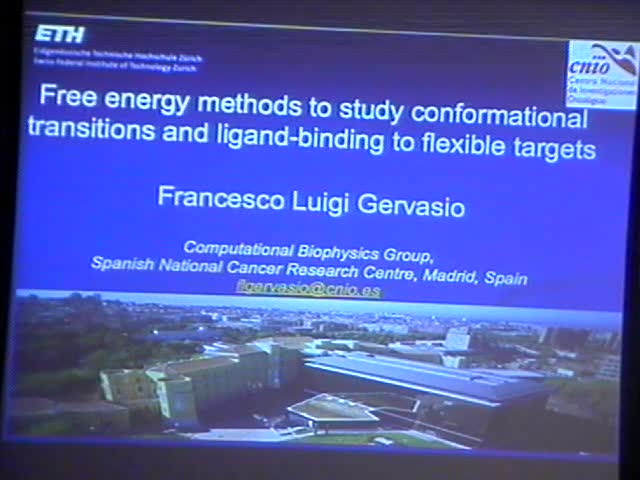Free-energy methods to study conformational transitions and ligand binding to flexible targets
Presenter
May 19, 2009
Keywords:
- Phase transitions
MSC:
- 82B26
Abstract
Large scale conformational rearrangements represent both a
challenge and an opportunity for rational drug design.
Exploring the conformational space of a target protein with sufficient detail is computationally very demanding and most current docking programs are very limited in this respect.
If it were possible, however, it could open the avenue to the design of
more selective drug candidates. Here we show how atomistic molecular
dynamics together with methods developed to accelerate rare events can
be used to study both kinase conformational transitions and ligand binding.
Using a new sampling method which is able to find the low free energy
channel between an initial and final state[1] we determined the atomistic dynamics of the open-to-closed movement of the cyclin dependent kinase 5 (CDK5). [4]
The inactivation movement has a two-step mechanism. First
alpha-C-helix rotates about 45 allowing the interaction between Glu51
and Arg149, then T-loop has to refold to assume the closed conformation.
We found out the key role of Arg149 in the closure movement as the
link residue between the N-lobe and the C-lobe, allowing a concerted movement
of the two lobes. We do not find evidence for the DFG out flip. A complementary
method, Metadynamics,[2,3] was used to study the undocking path of a
congeneric series of ligands to CDK2. Also in this case the large scale dynamics
of the kinase plays a fundamental role.
1. D. Branduardi, F. L. Gervasio and M. Parrinello. Rare events
in molecular systems: From A to B in Free Energy Space
J. Chem. Phys., 126, 054103, 2007.
2. F. L. Gervasio*, A. Laio and M. Parrinello. Flexible Docking in Solution Using Metadynamics J. Am. Chem. Soc., 127(8): 2600-2607, 2005.
3. A. Laio and F. L. Gervasio* Metadynamics: a method to simulate rare
events and reconstruct the free energy in biophysics, chemistry and material science
Rep. Prog. Phys. , 71, 126601 (22p), 2008.
4. A. Berteotti, A. Cavalli, D. Branduardi, F. L. Gervasio*, M. Recanatini and M. Parrinello, Protein Conformational Transitions: The Closure Mechanism of a Kinase Explored by Atomistic Simulations nism of CDK5. J. Am. Chem. Soc.,131, 244-250, 2009.
